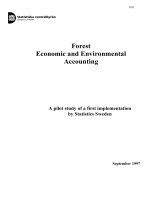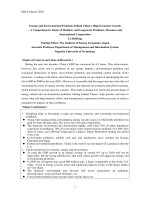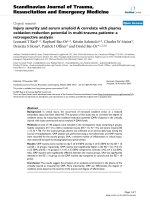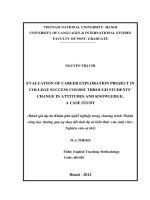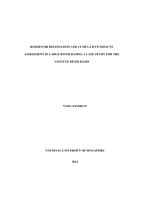Serum amyloid a (SAA) and cholesterol efflux a mechanistic study
Bạn đang xem bản rút gọn của tài liệu. Xem và tải ngay bản đầy đủ của tài liệu tại đây (2.12 MB, 188 trang )
SERUM AMYLOID A (SAA) AND CHOLESTEROL
EFFLUX A MECHANISTIC STUDY
LI HONGZHE
(Bachelor of Medicine, Capital University of Medical Sciences)
(Master of Science, National University of Singapore)
A THESIS SUBMITTED
FOR THE DEGREE OF DOCTOR OF PHILOSOPHY
DEPARTMENT OF PAEDIATRICS
NATIONAL UNIVERSITY OF SINGAPORE
2011
1
ACKNOWLEDGEMENTS
This project was generously supported by the National Medical Research Council,
Singapore (Grant NMRC/1155/2008). I would like to express my utmost gratitude to my
supervisor, Prof. Heng Chew-Kiat, for his advice, support and invaluable mentoring of
my scientific and personal development. I am very grateful for the opportunity to have
worked with him for my dissertation. It has been my privilege to learn from him. He has
been very patient and understanding as well as encouraging, guiding me through this
wonderful journey of discovery and learning.
I gratefully acknowledge the precious comments and advices from Prof. Samuel S
Chong, Prof. Lai Poh San and Prof. Teresa Tan.
Sincere gratitude also goes to Dr Zhang Yulan for her effort in initiating the
project as well as her valuable suggestions in my postgraduate study. I would also like to
express my utmost appreciation to all working under Prof. Heng’s group at one time or
another, for their friendship, the camaraderie spirit and many stimulating and enjoyable
lively discussions: Ms. Zhou Shuli, Ms. Karen Lee, Ms. Lye Hui Jen, Mr. Leow Koon
Yeow, Ms. Goh June Mei, Ms. Yang Ennan, Ms. Tan Si Zhen and Ms. Ke Tingjing and
many others.
A financial support from National University of Singapore is gratefully
acknowledged.
This work is dedicated to my family and my dear friends for their continuous
encouragement and support during my Ph.D study. Without their support, completing a
PhD study would be a far-fetch dream for me. Words cannot express how much I
2
appreciate you for sparking my creativity in various aspects of my life and for just being
around for me.
3
PUBLICATIONS
The major part of this work has been published in:
Serum Amyloid A Activates Peroxisome Proliferator-Activated Receptor γ through
Extracellularly Regulated Kinase 1/2 and COX-2 Expression in Hepatocytes. Hongzhe
Li, Yulan Zhao, Shuli Zhou and Chew-Kiat Heng. Biochemistry (2010) (In press)
Manuscript in preparation:
The role of NF-кB in SAA-induced PPARγ activation. Hongzhe Li and Chew-Kiat Heng
(2011)
4
SUMMARY
Coronary artery disease (CAD) is one of the leading causes of mortality in
developed countries. It most often results from atherosclerosis, a progressive condition
characterized by the accumulation of lipids and fibrous elements in the large arteries.
Many inflammatory proteins are elevated in this process and correlated with future
coronary events. One of such inflammatory proteins is serum amyloid A (SAA). SAA is
an acute phase protein whose level of expression increases markedly during bacterial
infection, tissue damage, and inflammation. The potential beneficial roles of SAA include
its involvement in reverse cholesterol transport and possibly extracellular lipid deposition
at sites of inflammation and tissue repair. It is an attractive therapeutic target for the
treatment of atherosclerosis. Peroxisome proliferator-activated receptor γ (PPARγ) plays
a major regulatory role in adipogenesis and in the expression of genes involved in lipid
metabolism. Activation of PPARγ leads to multiple changes in gene expression, some of
which are believed to be atherogenic while others are antiatherogenic. In this study, we
investigated the effects of SAA on PPARγ activation and its downstream target gene
expression profiles in HepG2 cells. We demonstrated that SAA could activate PPARγ
transcriptional activity. Preincubation of HepG2 cells with SAA enhanced the efflux of
cholesterol to HDL and apoA-I. In addition, SAA increased the level of intracellular 15-
deoxy-Δ
12,14
-prostaglandin J
2
(15d-PGJ
2
), which is a potent natural ligand for PPARγ.
Our data suggested that SAA activated PPARγ through extracellular signal-regulated
kinase 1/2 (ERK1/2) and NF-кB dependent COX-2 expression. Furthermore, SAA-
induced cholesterol efflux was suppressed when the ERK1/2 pathway or COX-2 was
inhibited. Overall, our study has established, for the first time, a relationship between
5
SAA and PPARγ. Additionally, the data from our study has also provided new insights
into the role of SAA in cholesterol efflux.
6
TABLE OF CONTENTS
Page
ACKNOWLEDGEMENTS 1
PUBLICATIONS 3
SUMMARY 4
TABLE OF CONTENTS 6
LIST OF FIGURES 13
LIST OF TABLES 16
LIST OF ABBREVIATIONS 17
CHAPTER I INTRODUCTION 22
1.1 Coronary artery disease and atherosclerosis 23
1.2 Atherosclerosis development 23
1.3 Inflammatory factors in atherosclerosis 25
1.4 Serum amyloid A (SAA) 27
1.4.1 The SAA family 27
1.4.2 Structure of human SAA proteins 29
1.4.3 Expression and induction of SAA 30
1.4.4 Functions of SAA 32
1.4.4.1 Immune-related functions 33
1.4.4.2 Anti-inflammatory roles 33
1.4.4.3 SAA, amyloid A protein and amyloidosis 34
1.4.4.4 Lipid-related functions 35
1.4.5 Receptors for SAA 38
7
1.4.5.1 SR-BI 38
1.4.5.2 FPRL-1 39
1.4.5.3 RAGE 40
1.4.5.4 TLRs 40
1.4.5.5 TANIS 41
1.4.6 SAA and cardiovascular disease 42
1.5 Peroxisome proliferator-activated receptor γ (PPARγ) 43
1.5.1 PPAR family 43
1.5.2 PPARγ activation 45
1.5.3 Functions of PPARγ 46
1.6 Mitogen-activated protein kinases (MAPKs) 50
1.6.1 General features and biological functions of MAPK 50
1.6.1.1 MAPK in cancer 51
1.6.1.2 MAPK in cell cycle 52
1.6.1.3 MAPK in apoptosis 53
1.6.2 SAA and MAPK 54
1.6.2.1 Endothelial cells 56
1.6.2.2 Monocytes 57
1.6.2.3 Fibroblasts 58
1.7 NF-кB 59
1.7.1 General features and biological functions of NF-ĸB 59
1.7.2 SAA and NF-кB 62
1.8 Reverse cholesterol transport 63
8
1.8.1 ABCA1-mediated cholesterol efflux 65
1.8.2 ABCG1-mediated cholesterol efflux 67
1.9 Objectives of the project 67
CHAPTER II MATERIALS AND METHODS 69
2.1 Materials 70
2.2 Routine cell line maintenance 72
2.2.1 Cells lines 72
2.2.2 Cells culture media 72
2.2.3 General cells culture procedures 73
2.3 SAA treatment 76
2.4 Measurement of endotoxin activity 77
2.5 RNA isolation 77
2.6 Quantitative real-time PCR (qRT-PCR) 78
2.7 Protein extraction 80
2.8 Membrane protein extraction 81
2.9 SDS-PAGE and Western blot 81
2.10 Nuclear protein extraction 83
2.11 Cholesterol efflux assay 84
2.12 PPARγ activity assay 85
2.13 Electrophoretic mobility shift assay 86
2.14 Transfection and luciferase assay 87
2.15 EIA for 15d-PGJ
2
88
2.16 NF-кB (p50) transcription factor assay 89
9
2.17 SAA-HDL association 89
2.18 siRNA mediated gene silencing 90
2.19 Bacterial work 92
2.19.1 Media 92
2.19.2 Competent cell preparation 92
2.19.3 Isolation of plasmid DNA from E.coli 93
2.19.3.1 Small scale preparation of plasmid DNA 93
2.19.3.2 Large scale preparation of plasmid DNA 93
2.20 Cloning 95
2.20.1 Cloning of SAA1 in the pcDNA™3.1(+) vector 95
2.20.1.1 Reverse transcriptase-PCR and purification 95
2.20.1.2 Digestion 96
2.20.1.3 Gel purification 97
2.20.1.4 Ligation 97
2.20.1.5 Transformation 98
2.20.1.6 Selection and DNA sequencing 98
2.20.2 Other subclonings 99
2.20.2.1 Generation of pcDNA3.1-SAA1-NLS 99
2.20.2.2 Generation of pcDNA3.1-SAA1-G8D 99
2.20.2.3 Generation of pcDNA3.1-SAA1Δ1-11 99
2.20.2.4 Generation of pcDNA3.1-PPARγ 100
2.21 Plasmid DNA transfection 100
2.22 Detection of SAA secretion 100
10
2.23 Statistical analysis 101
CHAPTER III RESULTS 102
3.1 SAA activates peroxisome proliferator-activated receptor γ through
extracellular-regulated kinase 1/2 and COX-2 expression in hepatocytes 103
3.1.1 SAA induces PPARγ and its target genes expression in
HepG2 cells 103
3.1.2 SAA facilitates cholesterol efflux in HepG2 105
3.1.3 SAA enhances PPARγ activativity in HepG2 108
3.1.4 SAA-induced PPARγ activation is suppressed by HDL 113
3.1.5 De novo protein synthesis is required for the SAA-induced
PPARγactivation 114
3.1.6 SAA-induced PPARγ activation and cholesterol efflux in
HepG2 is partially mediated by SR-BI 116
3.1.7 SAA increases intracellular 15d-PGJ
2
level 118
3.1.8 SAA induces COX-2 expression 119
3.1.9 SAA-induced PPARγ activation is mediated by ERK1/2
dependent COX-2 expression 121
3.1.10 AA has the same PPARγ activation effect in HCAEC and
THP-1 cell lines 125
3.2 SAA activates PPARγ through FPRL1 and TLRs-mediated NF-кB
activation 126
3.2.1 SAA stimulates NF-кB activity 126
11
3.2.2 SAA-induced COX-2 expression and PPARγ activation is
through NF-кB pathway 129
3.2.3 SAA-induced PPARγ activation is completely blocked by the
combination of ERK1/2 and NF-кB inhibitors 132
3.2.4 SAA-induced NF-кB activation is suppressed by HDL 132
3.3 SAA-induced effects are mediated by different receptors 134
3.3.1 FPRL-1 and TLR4 are involved in SAA-induced PPARγ and
NF-кB activation 134
3.3.2 SAA- enhanced cholesterol efflux is partially through SR-BI 136
3.3.3 NF-кB and PPARγ activation via FPRL-1 is SAA-selective 138
3.4 The N-terminal is essential for SAA protein expression, secretion and
cholesterol efflux 139
3.4.1 mutSAA protein expression and secretion are impaired in
HEK293 cells 139
3.4.2 Cholesterol efflux is impaired in HEK293 cells transfected with
mutSAA constructs 142
3.4.3 PPARγ activity is impaired in HEK293 cells transfected with
mutSAA constructs 143
CHAPTER IV DISCUSSION 144
4.1 SAA induces PPARγ activation 146
4.2 SAA induces the expression of ABCA1, ABCG1 and enhances
cholesterol efflux 149
4.3 The effect of SAA is not due to bacterial contamination in recombinant
12
SAA protein 151
4.4 Lipid free SAA and HDL-conjugated SAA have different effects 152
4.5 SAA induces COX-2 expression and subsequently increases the
intracellular 15d-PGJ
2
level 154
4.6 SAA-induced COX-2 expression could be mediated through ERK1/2
and NF-кB 156
4.7 The receptors involved in SAA-induced effects 158
4.8 The essential role of N-terminal SAA in protein expression, secretion,
cholesterol efflux and PPARγ activation 161
CHAPTER V CONCLUSIONS AND FUTURE WORK 165
5.1 Main findings 166
5.2 Summary of major contributions of this study 166
5.3 Suggestions for future work 167
CHAPTER VI REFERENCES 169
13
LIST OF FIGURES
Figure No. Page
1. Schematic representation of the atherosclerotic lesion development. 25
2. The structure of human SAA protein. 30
3. Induction of SAA during the acute-phase response. 32
4. Classical structure of PPAR with the zinc fingers which interact
with specific response elements located in the target genes. 44
5. Regulation of cholesterol efflux pathways in macrophages by
PPARγ and LXRα. LXRα agonists stimulate the expression of
ABCA1, which facilitates the efflux of cholesterol to lipid-poor
apolipoprotein A-I (apoA-I), and ABCG1, which facilitates
the efflux of cholesterol to HDL. 49
6. Model of the generic NF-кB activation pathway. 61
7. Mechanisms of cholesterol efflux from the arterial wall. 65
8. Figure 8. Map of pcDNA™3.1(+). 96
9. SAA induces PPARγ, LXRα, ABCA1 and ABCG1 gene expression
in HepG2 cells. 103
10. SAA facilitates cholesterol efflux in HepG2 cells. 105
11. SAA-facilitated cholesterol efflux in HepG2 cells was mediated
by ABCA1 and ABCG1. 107
12. SAA enhances PPARγ activation and SAA-induced PPARγ
target genes expressions are inhibited by PPARγ antagonist. 110
13. SAA-induced PPARγ activity is suppressed in the presence of HDL. 113
14
14. De novo protein synthesis is required for the SAA-induced
PPARγ activation. 115
15. SAA-induced PPARγ activation and cholesterol efflux in HepG2
is partially mediated by SR-BI. 117
16. SAA induces intracellular 15d-PGJ
2
in HepG2. 119
17. SAA-induced COX-2 gene expression is involved in PPARγ
activation in HepG2 cells. 120
18. SAA-induced PPAR activation is mediated by ERK1/2. 122
19. SAA enhances PPARγ activity in HCAEC and THP-1 cell lines. 126
20. SAA stimulates NF-кB activation. 128
21. SAA-induced COX-2 expression and PPARγ activation is through
NF-кB pathway. 130
22. SAA-induced PPARγ activation is completely blocked by the
combination of ERK1/2 and NF-кB inhibitors. 132
23. SAA-induced NF-кB activity is inhibited by HDL association. 133
24. FPRL-1 and TLR4 are involved in SAA-mediated effects. 135
25. SAA-enhanced cholesterol efflux is partially through SR-BI. 137
26. NF-кB and PPARγ activation via FPRL-1 is SAA-selective. 138
27. The SAA mRNA levels are similar after transfection with different
constructs. 140
28. Cholesterol efflux is impaired in HEK293 cells transfected with
mutSAA constructs. 142
29. PPARγ activity is impaired in HEK293 cells transfected with mutSAA
15
constructs. 143
30. Schematic diagram of the proposed mechanism of cholesterol efflux
through SAA-induced PPARγ activation of its target genes. 146
16
LIST OF TABLES
Table No. Page
1. SAA-induced signaling and cellular responses 55
2. Characteristics of the inhibitors mentioned in Table 1 56
3. Cell lines used in this study 72
4. Primer sequences for qRT-PCR analysis 79
5. Compositions of SDS-PAGE 82
6. siRNA sequences for gene silencing 90
7. ELISA measurement of SAA in transfected HEK293 cells 141
17
LIST OF ABBREVIATIONS
15d-PGJ
2
15-deoxy-Δ
12,14
-prostaglandin J
2
AA arachidonic acid
ABCA1 ATP-binding cassette, sub-family A (ABCA), member 1
ABCG1 ATP-binding cassette, sub-family G (ABCG), member 1
ACAT acyl-CoA cholesteryl acyl transferase
AMI acute myocardial infarction
Amp ampicillin
AP-1 activator protein 1
APP acute phase protein
apo apolipoprotein
BAY 11-7082 (E)-3-(4-Methylphenylsulfonyl)-2-propenenitrile
CAD coronary artery disease
CAM cellular adhesion molecule
CLA-1 CD36 and LIMPII analogous-1
CMV Cytomegalovirus
COX-2 cyclooxygenase-2
CRP C-reactive protein
CSF colony stimulating factor
DMSO dimethyl sulfoxide
DTT 1,4-Dithiothreitol
EC endothelial cell
18
ECM extracellular matrix
EDTA ethylene diamine tetra-acetic acid
EGFR epidermal growth factor receptor
EIA enzyme immunoassay
ELISA enzyme-linked immunosorbent assay
EMSA electrophoretic mobility shift assay
ERK1/2 p44/42 MAP kinase
E-selectin endothelial cell-derived selectin
EU endotoxin unit
FBS fetal bovine serum
FCS fetal calf serum
FGF fibroblast growth factor
FPRL-1 formyl peptide receptor like 1
GAPDH glyceraldehydes-3-phosphate dehydrogenase
GPCR G-protein coupled receptor
HCAEC human coronary artery endothelial cell
HDL high density lipoprotein
HEK human embryonic kidney
HRP horseradish peroxidase
HUVEC human umbilical vein endothelial cell
ICAM intercellular adhesion molecule 1
IKK IкB kinase
IL interleukin
19
IкB inhibitor of NF-кB
JNK c-jun terminal NH
2
kinase
LB Luria Broth
LCAT lecithin-cholesterol acyltransferase
LDL low density lipoprotein
LDLR low density lipoprotein receptor
LPS lipopolysaccharide
LXR liver X receptor
MAPK mitogen-activated protein kinase
MCP-1 monocyte chemotactic protein 1
MMP matrix metalloproteinsease
MSK mitogen- and stress-activated protein
kinase
nCEH neutral cholesterol ester hydrolase
NF-кB nuclear factor kappa B or nuclear factor of kappa light polypeptide gene
NO nitric oxide
NS-398 N-[2-(Cyclohexyloxy)-4-nitrophenyl]methanesulfonamide (NS-398)
p38 p38 MAP kinase
PBS phosphate buffered saline
PCR polymerase chain reaction
PD98059 2-(2-Amino-3-methoxyphenyl)-4H-1-benzopyran-4-one
PDGF platelet-derived growth factor
PECAM-1 platelet-endothelial-cell adhesion molecule 1
PG prostaglandin
20
PMB polymyxin B
PPAR peroxisome proliferator-activated receptor
PPRE peroxisome proliferators response element
PTX pertussis toxin
qRT-PCR quantitative real-time polymerase chain reaction
RAGE receptor for advanced glycation end products
ROS reactive oxygen species
RXR retinoid X receptor
SAA serum amyloid A
SAF SAA-activating factor
SDS sodium dodecyl sulphate
siRNA synthetic interfering RNA
SMC smooth muscle cell
sPLA
2
-IIa group-IIa secretory phospholipase A
2
SR-BI scavenger receptor class B type I
T0070907 2-Chloro-5-nitro-N-4-pyridinyl-benzamide
TBS tris-buffered saline
TdT terminal deoxynucleotidyl transferase
TEMED tetramethylethylenediamine
TF tissue factor
TFPI tissue factor pathway inhibitor
TGF transforming growth factor
TLR toll-like receptor
21
TNFα tumor necrosis factor-alpha
TXA
2
thromboxane A
2
TZD thiazolidinedione
VCAM-1 vascular cell adhesion molecule 1
VEGF vascular endothelial growth factor
22
CHAPTER I
INTRODUCTION
23
1.1 CORONARY ARTERY DISEASE AND ATHEROSCLEROSIS
Coronary arteries deliver oxygen-rich blood to the myocardium. Coronary artery
disease (CAD) is the end result of the accumulation of atheromatous plaques within the
walls of the coronary arteries that supply the myocardium with oxygen and nutrients. It is
sometimes also called coronary heart disease (CHD). CAD is the most common form of
heart disease. It is one of the leading causes of mortality in developed countries [1]. It
most often results from atherosclerosis, a progressive condition characterized by the
accumulation of lipids and fibrous elements in the large arteries.
1.2 ATHEROSCLEROSIS DEVELOPMENT
Our views of the pathophysiology of atherosclerosis have evolved substantially
over the past century. The link between lipids and atherosclerosis dominated our thinking
based on strong experimental and clinical relationships between hypercholesterolaemia
and atheroma [2]. More recently, a prominent role of inflammation was discovered for
the development of atherosclerosis and its complications [3-5]. In fact, the lesions of
atherosclerosis represent a series of highly specific cellular and molecular responses that
can best be described, in aggregate, as an inflammatory disease [6].
The earliest changes that precede the formation of lesions of atherosclerosis take
place in the endothelium. These changes include increased endothelial permeability to
lipoproteins and other plasma constituents, up-regulation of leukocyte adhesion
molecules, up-regulation of endothelial adhesion molecules, and migration of leukocytes
into the artery wall (Fig. 1a). Then the fatty streaks start to build up in the arteries. Fatty
24
streaks initially consist of lipid –laden monocytes and macrophages (foam cells) together
with T lymphocytes. Later they are joined by various numbers of smooth-muscle cells
(Fig. 1b). The steps involved in this process include smooth-muscle migration, T-cell
activation, foam cell formation, and platelet adherence and aggregation. As fatty streaks
progress to intermediate and advanced lesions, they tend to form a fibrous cap that walls
off the lesion from the lumen (Fig. 1c). This represents a type of healing or fibrous
response to the injury. The fibrous cap covers a mixture of leukocytes, lipid, and debris,
which may form a necrotic core. Continuing influx and activation of macrophages could
increase metalloproteinases and other proteolytic enzymes at the advanced lesion, which
results in the thinning of the fibrous cap (Fig. 1d). Finally, rupture of the fibrous cap can
rapidly lead to thrombosis and occlusion of the artery. It usually occurs at sites of
thinning of the fibrous cap that covers the advanced lesion.


